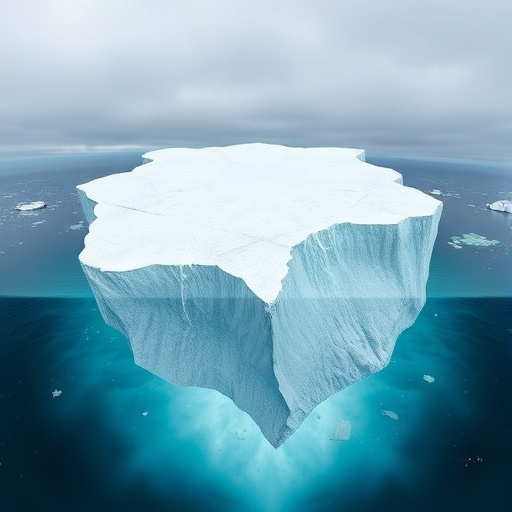In a pivotal study published in Nature Geoscience, researchers have unveiled groundbreaking insights into how meltwater from colossal icebergs influences the upper ocean’s physical and chemical properties. This research, conducted through proximate and innovative measurement techniques, sheds new light on the intricate processes occurring at the interface of melting ice masses and the ocean—phenomena critical for understanding global climate dynamics and predicting future marine changes.
Giant icebergs, often spanning tens of kilometers in length, serve as immense freshwater reservoirs adrift in the ocean. Their melting injects vast quantities of cold, fresh meltwater into the surrounding seawater, causing localized modifications in salinity, temperature, and density. These changes, while seemingly limited to a small geographic scale, can have cascading effects on regional ocean circulation and marine ecosystems, influencing heat distribution, nutrient cycling, and the broader climate system.
The research team deployed a suite of advanced oceanographic instruments directly adjacent to a massive iceberg in polar waters, enabling unparalleled real-time measurements of meltwater dispersal and its oceanographic consequences. This proximity allowed for capturing subtle gradients in temperature and salinity that are often missed by conventional remote sensing or distant sampling methods. Their instruments collected high-resolution data on water column stratification, turbulence intensity, and chemical tracer concentrations in the immediate vicinity of the iceberg margins.
Findings reveal that meltwater forms a stratified surface layer that markedly inhibits vertical mixing, stabilizing the upper ocean structure. This stratification creates a cold, fresh lens atop warmer, saltier waters below, which can significantly perturb heat exchange between the ocean and atmosphere. Such changes have implications for local weather patterns and, potentially, larger-scale climate feedback mechanisms due to altered ocean-atmosphere heat fluxes.
Moreover, the meltwater’s dilution effect on upper ocean salinity was found to influence seawater density profiles, which in turn modulate ocean currents. The altered current patterns can affect nutrient upwelling and distribution, thereby impacting biological productivity. Microbial and plankton communities, the foundation of marine food webs, are particularly sensitive to such changes, emphasizing the interconnectedness between physical oceanographic processes and marine ecology.
The team’s sophisticated measurements also highlighted the variable rate of meltwater entrainment into the ocean, dictated by dynamic factors such as iceberg shape, motion, and ambient water conditions. Topographic features of the iceberg’s submerged portions generate complex flow patterns and localized eddies that enhance or suppress meltwater mixing, affecting how the freshwater spreads and settles.
Notably, this investigation identified episodic bursts of meltwater discharge during iceberg calving events and wave-induced fracturing, which temporarily disrupt ocean stability and can accelerate nutrient export to deeper waters. These transient phenomena underscore the nonlinear nature of iceberg-ocean interactions and the need for integrating temporal variability into predictive models.
Understanding meltwater impacts is critical in the context of accelerating ice mass loss observed in polar regions due to climate warming. As giant icebergs become more prevalent and drift into lower latitudes, their influence on coastal and open ocean systems may intensify, potentially triggering feedback loops that alter thermohaline circulation patterns on regional to global scales.
This research contributes to filling significant gaps in existing climate models that have historically treated icebergs as relatively static freshwater sources or have lacked fine-scale observations necessary to resolve meltwater dynamics. By incorporating the empirical data from direct iceberg measurements, the scientific community can improve simulations of polar ocean responses and their global climate repercussions.
The methodological approach demonstrated here—deploying proximate measurement platforms capable of capturing high-resolution physical and chemical data near drifting ice masses—represents a breakthrough in oceanographic fieldwork. It opens possibilities for future studies to explore the diverse impacts of ice-ocean interactions with higher spatial and temporal fidelity.
Implications of these findings extend to navigation safety and resource exploration, as iceberg meltwater regions can produce salinity gradients and surface current anomalies that influence marine vessel operations and the distribution of commercially valuable fish stocks. Understanding these transient ocean conditions can thus inform ecological management and maritime policies in polar-adjacent waters.
In addition, the insights into meltwater stratification and ocean mixing pave the way for interdisciplinary research linking physical oceanography with biogeochemistry and marine biology. Future work is poised to elucidate how altered nutrient regimes in iceberg melt zones affect carbon cycling and sequestration, with broader ramifications for global carbon budgets and climate mitigation strategies.
As climate change continues to reshape polar environments, targeted studies such as this one are essential to comprehensively map the evolving cryosphere-ocean interface. These findings also stress the importance of sustained monitoring and investment in innovative oceanographic technologies capable of operating under extreme and dynamic polar conditions.
The ongoing exploration of iceberg meltwater effects represents a frontier in earth system science, blending fieldwork ingenuity with cutting-edge instrumentation. The collective knowledge generated not only enhances fundamental understanding but also strengthens predictive capabilities vital for anticipating and adapting to rapidly shifting polar and global ocean systems.
Ultimately, this research underscores the interconnectedness of terrestrial and marine processes, highlighting how the disintegration of giant icebergs—symbols of polar ice loss—is intricately tied to the evolving physical state of the oceans, with significant and far-reaching consequences for climate, ecosystems, and human society.
Subject of Research: Effects of iceberg meltwater on upper ocean physical and chemical properties.
Article Title: Proximate measurements of a giant iceberg reveal the effects of meltwater on upper ocean properties.
Article References:
Proximate measurements of a giant iceberg reveal the effects of meltwater on upper ocean properties. Nat. Geosci. 18, 281–282 (2025). https://doi.org/10.1038/s41561-025-01660-0
Image Credits: AI Generated




